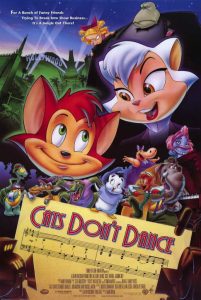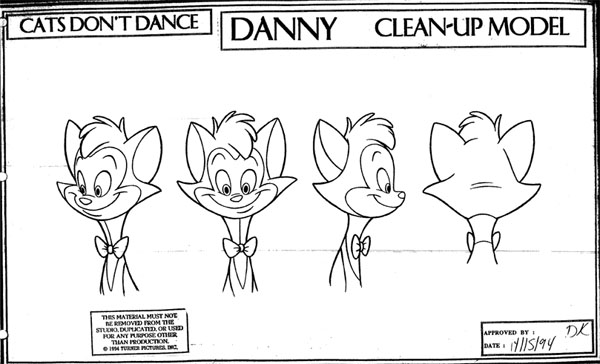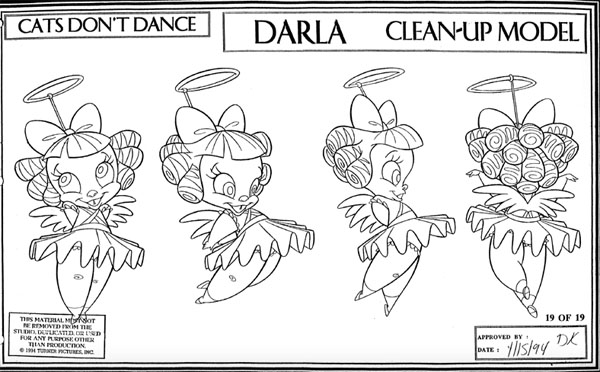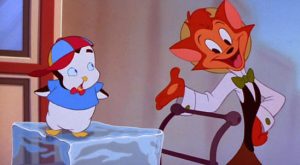
An overlooked gem. That’s what Cat’s Don’t Dance is. Sadly, when it was released twenty-five years ago, the film became a casualty of a studio merger and arrived with almost no marketing fanfare behind it. It quickly sank at the box office, with the animation studio that produced it eventually shutting its doors.
 Other higher-profile animated films took the spotlight, as Cat’s Don’t Dance faded into the background during the animation renaissance of the 1990s.
Other higher-profile animated films took the spotlight, as Cat’s Don’t Dance faded into the background during the animation renaissance of the 1990s.
But the passage of time can be kind, and it has been to this film. Through the years, many “Hey, have you ever seen?” conversations among animation enthusiasts have allowed Cat’s Don’t Dance to find the appreciation it deserves. It’s a distinct film, filled with its brand of sharp humor and satire.
If you haven’t seen it in some time or are one of the many who still haven’t seen it, this year’s twenty-fifth anniversary of Cat’s Don’t Dance is the perfect opportunity to visit or re-visit the film.
“Rats were overrunning the Warner Brothers Studio,” said the film’s director Mark Dindal, in a 1997 interview, discussing the Hollywood fable behind the inspiration for Cat’s Don’t Dance. “They went out to the local pound and brought in all of these cats, that nobody claimed, to take care of this problem. There was a story that was based around that, but it evolved and evolved into the story that we now have.”
The earlier versions of Cat’s Don’t Dance date back to 1993 and were fashioned as a live-action/animated vehicle for Michael Jackson, who eventually left the project.


It became the tale of Danny, a cat from Kokomo, Indiana, who comes to Hollywood in 1939 with hopes of pursuing his dream of becoming a movie star.
Danny and his other animal friends experience prejudice, as no animals can get any leading roles in the movies. So, they all wind up working for child star Darla Dimple, who is as sweet as Shirley Temple on screen, but off-screen is a pint-sized tyrant. She sees Danny and the other animals as a threat, sabotages their audition, and leaves them without jobs. The animals then look to make sure Hollywood knows Darla for the diabolical brat that she is.
 The film’s art director Brian McEntee created a very time-appropriate look for Cat’s Don’t Dance. “We explored the art deco style as our springboard,” said McEntee in 1997, just before the film’s release. “What I liked about deco is that it’s formal and elegant and clean, but at the same time is kind of dynamic, which relates really well to the tone of the story.”
The film’s art director Brian McEntee created a very time-appropriate look for Cat’s Don’t Dance. “We explored the art deco style as our springboard,” said McEntee in 1997, just before the film’s release. “What I liked about deco is that it’s formal and elegant and clean, but at the same time is kind of dynamic, which relates really well to the tone of the story.”
Cat’s Don’t Dance featured the voices of Quantum Leap’s Scott Bakula as Danny, Jasmine Guy (A Different World), as Danny’s love interest, Sawyer (with Natalie Cole providing the singing voice) and Ashley Peldon as Darla. There’s also an excellent cast in supporting roles: Kathy Najimy voices a soprano-singing hippo named Tillie, Don Knotts is T.W., a swashbuckling turtle, John Rhys-Davies is Woolie the Elephant, Hal Holbrook is Cranston Goat and Betty Lou Gerson (who had voiced Cruella DeVil) is the fish, Frances Albacore.
 Another of the famous names connected with Cat’s Don’t Dance is the film’s choreographer: Gene Kelly. The late, great legend brought his unique talents and sensibilities to the film, guiding dance scenes.
Another of the famous names connected with Cat’s Don’t Dance is the film’s choreographer: Gene Kelly. The late, great legend brought his unique talents and sensibilities to the film, guiding dance scenes.
Dindal noted, during production, that working alongside him was an incredible experience. “The thing that really impressed me was that we would sit down and show him our storyboards and talk about what we were thinking, and he would remember specifics in whatever film we’d ask him about. Some of them were [at the time] forty years ago! I just think that’s amazing.”
Cat’s Don’t Dance was the first film from Turner Feature Animation. Unfortunately, it would be the only film released by the animation studio. During the film’s production, Time Warner merged with the Turner Broadcasting System. Cat’s Don’t Dance was lost in the various shuffles as studio leadership changed, and, sadly, Turner Feature Animation closed.
When the film opened on March 26th, 1997, it arrived with very little marketing, generated only $3.6 million at the box office, and quickly disappeared.
 Despite this, critics noted just how unique Cat’s Don’t Dance was. Roger Ebert wrote that director Dindal “…creates a fresh look for animation: not Disney, and not Looney Tunes, but a touch of Betty Boop and Max Fleischer.”
Despite this, critics noted just how unique Cat’s Don’t Dance was. Roger Ebert wrote that director Dindal “…creates a fresh look for animation: not Disney, and not Looney Tunes, but a touch of Betty Boop and Max Fleischer.”
Lawrence Van Gelder noted in The New York Times: “Cat’s Don’t Dance is no saccharine fantasy. Its Hollywood references and dark satire constitute its real strengths.”
Twenty-five years after its debut, Cat’s Don’t Dance gained attention, particularly from those who missed it during its initial release. After the film, Dindal transitioned over to Disney, where he would direct 2000’s The Emperor’s New Groove, another film that found its audience well after its debut.
Fans of that film have often become Cat’s Don’t Dance devotees, as it has many similar comic sensibilities. They now see what many already know. Cat’s Don’t Dance is an overlooked gem.


 Michael Lyons is a freelance writer, specializing in film, television, and pop culture. He is the author of the book, Drawn to Greatness: Disney’s Animation Renaissance, which chronicles the amazing growth at the Disney animation studio in the 1990s. In addition to Animation Scoop and Cartoon Research, he has contributed to Remind Magazine, Cinefantastique, Animation World Network and Disney Magazine. He also writes a blog, Screen Saver: A Retro Review of TV Shows and Movies of Yesteryear and his interviews with a number of animation legends have been featured in several volumes of the books, Walt’s People. You can visit Michael’s web site Words From Lyons at:
Michael Lyons is a freelance writer, specializing in film, television, and pop culture. He is the author of the book, Drawn to Greatness: Disney’s Animation Renaissance, which chronicles the amazing growth at the Disney animation studio in the 1990s. In addition to Animation Scoop and Cartoon Research, he has contributed to Remind Magazine, Cinefantastique, Animation World Network and Disney Magazine. He also writes a blog, Screen Saver: A Retro Review of TV Shows and Movies of Yesteryear and his interviews with a number of animation legends have been featured in several volumes of the books, Walt’s People. You can visit Michael’s web site Words From Lyons at: 






















Wow, 25 years. I still remember seeing this in the theater, and it leaving before I could convince my parents to take me again. I was devastated because the movie was so good and couldn’t understand why it was suddenly gone! I’m guessing it didn’t get much advertising outside of Warner-affiliated venues because I definitely remember seeing ads for it many times on Cartoon Network.
I eagerly anticipated its home video release and when I finally had a copy I watched it so many times I learned the movie by heart. Sure, the 1990s produced many memorable animated films, but this one just spoke to me as no others did, with it’s blend of not just stunning music and art, but the knowing winks at Hollywood history and animation’s satires of same during the Golden Age.
I like Dindal’s Emperor’s New Groove better, but this one has some fun stuff in it, like the screwball comedy dialogue between the two leads, and Darla Dimple’s subversion of the “cute and adorable child actor” trope.
I have the film on DVD and I loved it. I just couldn’t get around this one thought that kept cropping up. How the hell can an elephant play piano without fingers? That always bothered me for some reason, lol…
Still one of my all-time favorites! The art direction and the animation are unlike anything else I’ve seen – still – and the music is amazing and funny, too. Well written, well paced, just a beautiful film. The character design, layouts and backgrounds(!), all the sublime colors and lighting! I didn’t even know it had been released until it hit the dollar theaters, and then my wife and I went back for its last 2 or 3 nights in a row – on weekday nights – and then it was just gone! She still shows it to her 1st grade classes.
Gene Kelly played a character named Danny in the 1944 musical “Cover Girl”, starring Rita Hayworth. It was Columbia’s first musical in Technicolor, and the first film that Kelly choreographed; MGM had hitherto refused to give him the opportunity. “Cover Girl” was one of the most successful musicals of the ’40s and a landmark in Kelly’s career. Many years later he reprised the character of Danny McGuire in his final acting role in a film, the 1980 musical “Xanadu”, starring Olivia Newton-John.
I have absolutely no recollection of any advertising or reviews for “Cats Don’t Dance” in 1997. I never even heard of it until many years later. To this day I have not seen it. As you say, this 25th anniversary year may be the perfect time to do so. It sounds like a film I’d enjoy very much.
As happened with big-budget roadshow musicals released after “The Sound of Music” thirty years earlier, 2D animated features past “Lion King” and “Toy Story” began to find it rough going at the box office. Underpublicity aside, “Cats Don’t Dance” (working title “Big and Loud”) was too campy for kids, too cute for their parents, and too 1950s Hollywood in-jokey for mainstream audiences. It’s doubtful it would have been a success in the best of circumstances. Harking back to the fifties also proved a liability for the great “Iron Giant,” and a recherche feline-centric story doomed “Gay Purr-ee” 35 years before “Cats Don’t Dance.” It’s an enjoyable movie, though, and might have found its audience with repeated TV showings a decade or so earlier. (Nowadays a movie has to originate on streaming to get any serious attention.)
Well, it was set way earlier than the 50s – right around 1940, and I don’t think the retro setting is what held back Iron Giant anyway. Iron Giant had some humor that seemed in poor taste for a “kids’ movie” back then – “edgy” was the word – and it just didn’t fit the lite tone that some expected.
Cats Don’t Dance probably didn’t seem edgy enough for many and yes, Danny’s camp levels were pretty high. But really, some publicity would have at least put in on the map, even though it wasn’t a summer or holiday release. I’m shocked to see Nic Kramer letting us know of seeing actual TV advertising. Never heard of that before.
Also – I had no idea that was the working title! Thanks for the nugget!
Thank you for reminding me that the film was actually set in the late ’30s; I’d forgotten the references to “The Wizard of Oz” and “Gone With the Wind.” Still, there are a some anachronisms (Danny wouldn’t have been wearing a zoot suit), but why quibble?
Darla Dimple is so obviously based on Tina Denmark, the “criminally talented” anti-heroine of the musical “Ruthless” (Darla’s singing voice Lindsay Ridgeway played Tina in the 1993 Los Angeles run) that it’s a shame Bob Mackie, who designed that production, didn’t design this film. His costume sketches for stars like Cher, Carol Burnett, and Mitzi Gaynor, exaggerated glamor, are very cartoony.
I’ve mentioned before (elsewhere if not on this site) that the first time I learned of the existence of this film was when it was featured on the cover of some computer trade journal, right around the time of its release. It certainly seems like WB was trying to bury the film. To this day, it’s not available on Blu-ray, and while the 2016 print-on-demand Warner Archive DVD release at least keeps the widescreen ratio (unlike the previous DVD release), it’s apparently a mediocre transfer with no special features.
I recall this film indeed was advertied on television and they even promoted “Pullet Surprise”, the Foghorn Leghorn short that shown in front of the film and when it aired on Cartoon Network.
I remember this being advertised fairly heavily on the UK Cartoon Network, although that must have been for the VHS release as it seems this did not have a theatrical release in the UK.
Needs a Blu-ray, with as many dubs as you can fit on there.
Having missed its short theatrical run, I was thrilled to buy the LaserDisc when it came out. Yes, it’s a gem. And yes, I need to re-watch it soon. Also, as a huge fan of Quantum Leap and the many talents of Scot Bakula, i thought it was quite cool that he got to headline this musical.
Probably sooner than this, but to me this was the start of Warner Bros just sabotage everything they did. They sat on this, destroyed Quest for Camelot from the inside out, sat on Iron Giant, let the Farrelly Bros run all over Osmosis Jones, made that nasty Scooby-Doo live action movie. Just wow, all the way around.
I’ve been asking movie critics and animation buffs on YouTube if anyone had seen the Danny and Sawyer characters among WB entertainment’s roster of IP characters in the game sequence of [i]Space Jam: A New Legacy[/i]. And so far, not a trace of them has been spotted by anyone. I suppose that pretty much sums up WB’s willingness, or lack thereof, to even acknowledge the existence of the film. Yet despite this, [i]Cats Don’t Dance[/i] has developed a core of fans over the last quarter century that are keeping it’s memory alive to this day, especially considering it’s potential to continuously inspire fanart from online artists.